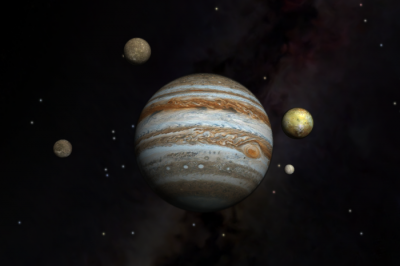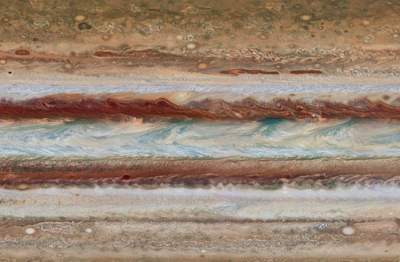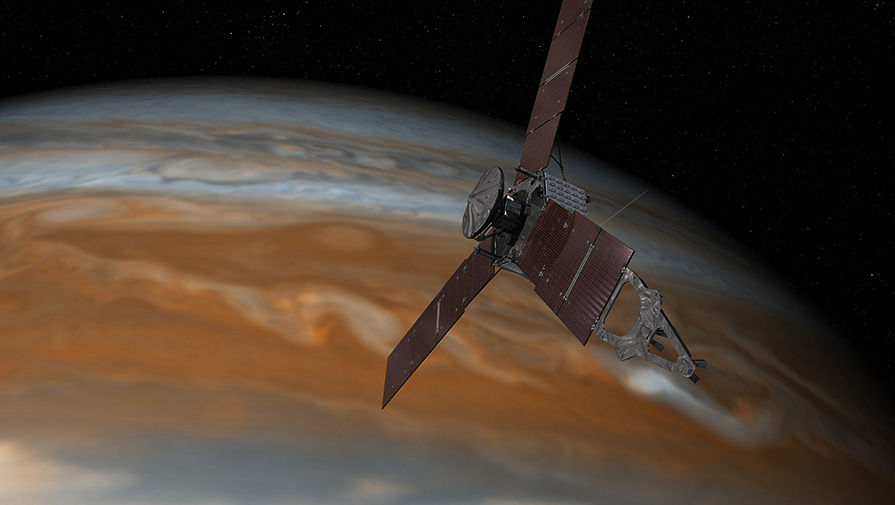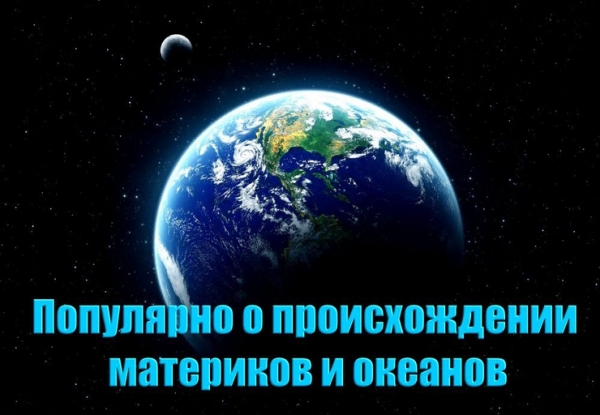 It is the largest planet in the Solar system.
It is the largest planet in the Solar system.
In Roman mythology Jupiter was the Supreme God, the Lord of lightning and thunder. The planet Jupiter is not only the largest in the Solar system, but also one of the most mysterious, many of the mysteries scientists can’t solve today. In our review of the ten most interesting facts about the “gas giant”, which is the fifth planet from the Sun.
1. Jupiter could be a star

In 1610 Galileo discovered Jupiter and its four main satellites: Europe, IO, Kallisto and Ganymede, which are now known as the “Galilean satellites”. It was the first time in history when people observed any other celestial body in the Solar system besides the moon. The opening of Galileo has provided excellent support for the Polish astronomer Nicolaus Copernicus and his theory that the Earth is not the center of the Universe.
The mass of the largest planet in the Solar system, twice the mass of the rest of the other bodies in the Solar system combined (not counting the Sun). The atmosphere of Jupiter is very similar to the star consists mainly of hydrogen and helium. Scientists believe that if Jupiter were about 80 times more, he would have become a star. Now it’s essentially a miniature solar system with its 4 huge satellites and 63 smaller ones. Jupiter is so massive, that it is 1300 times bigger than Earth.
2. The Great Red Spot

Great bands on Jupiter (which are probably seen by every person) caused by the constant strong winds that blow at speeds up to 650 kilometers per hour. Zones of white clouds in the upper atmosphere composed of frozen ammonia and crystallinemoonlight. The dark clouds that contain other chemicals, are found in the middle layers of the atmosphere, and the blue clouds are observed on the deepest visible layers of the atmosphere.
Most on Jupiter stands a giant super-storm called the Great red spot, which has been raging for 300 years. Rotating counterclockwise the Great red spot three times the diameter of the Earth. The wind in the center speeds up to 450 kilometers per hour. The great red spot is constantly changing in size, and sometimes it even seems that it disappears, but then returns again.
3. Incredible magnetic field of Jupiter

Due to the magnetic field, which is almost 20 thousand times stronger than Earth, Jupiter can be considered a real “magnetic king” of our planetary system. Jupiter picks up and attracts electrically charged particles that continuously bombard the system with radiation levels 1000 times higher than the fatality rate for humans. This radiation is so intense that it can damage even the most heavily shielded spacecraft of NASA, such as the Galileo probe.
Jupiter has a magnetosphere, which stretches for a staggering 1 – 3 million kilometers towards the Sun and stretches like a tail, for a gas giant, flying in orbit around the Sun,… of 1 billion kilometers.
4. Rabid wolfy
Jupiter, despite its huge size, makes a complete revolution around its axis in less than 10 hours (compared to 24 hours in the case of the Earth). Being a gaseous planet, Jupiter does not rotate as a solid planet like Earth. Instead, it rotates slightly faster at the equator than in the polar regions (with an average speed of 50,000 kilometers per hour, or 27 times faster than Earth). Therefore, the day on Jupiter lasts 9 hours and 56 minutes on both poles and 9 hours and 50 minutes near the equator of a giant planet. It’s extremely fast rotation causes Jupiter more convex at the equator and flattened at the poles.
5. Jupiter is the largest radio in the Solar system

Another area that highlights the Jupiter, it “blasts” the most powerful natural radio waves, which are produced by this planet, creating a terrible noise when receiving radio short-wave radio on Earth. These radio emissions are generated naturally due to the unstable plasma in the magnetosphere of a gas giant. When they first opened scientists on earth, these radio waves have caused quite a stir because they felt the talks of aliens.
Most astrophysicists assume that the ionized gases of the upper atmosphere of Jupiter and its magnetic poles sometimes act as a very strong radio laser, producing radiation so intense that a gas giant is quite often outshines even the sun as the source of radio waves. Scientists believe that the strength of this phenomenon in some way connected with volcanic moon IO.
6. Jupiter’s Rings

NASA scientists were surprised when in 1979 the spacecraft Voyager 1 discovered three rings around the equator of Jupiter. These rings are much fainter than the rings of Saturn and they simply could not see from the Ground. The main ring is about 30 km thick and 6000 km wide, and the flat inner ring of cloud, which are called “Ring halo” in thickness is about 20 000 km And the Main ring and the Halo are composed of small dark particles. The third ring, also known as “Spider”, in fact, consists of three rings composed of microscopic debris from three satellites of Jupiter – Adrastea, Thebes and Amalthea.
7. Protector of planets

Since Jupiter is the largest celestial body in the Solar system (except the Sun), its gravitational forces may have helped in the formation of literally the entire rest of the Solar system. According to a study published in the journal Nature, Jupiter, perhaps, “pushed Uranus and Neptune into the modern orbit of these planets. And according to an article published in the journal Science, Jupiter, along with Saturn may also “put” a huge amount of debris on the inner planets during the early history of the Solar system.
Also, scientists now almost certain that the Russian gas giant is holding back some asteroids, “not allowing” them to the Ground. Current data show that the gravitational field of Jupiter exerts a strong influence on many asteroids.
8. The giant Jupiter, and little Earth – same size

Scientists suggest that the inner core of Jupiter is 10 times smaller than the entire planet Earth And it is most likely made of liquid metallic hydrogen. The diameter of the Earth is nearly 13,000 kilometers, so the core of Jupiter should be slightly less than 1300 km across. This makes it size comparable to the size of the Earth’s core, which I believe is around 1200 kilometers in diameter.
9. The atmosphere of Jupiter: a dream for a chemist and a nightmare for everyone else

The composition of the atmosphere of Jupiter is essentially a mixture of 89.2 percent molecular hydrogen and 10.2% helium. The rest of the atmosphere consists of trace quantities of ammonia, hydrogen deuteride, methane, ethane, water, ammonia ice, frozen water and ammonia hydro-sulfide aerosols. Due to the magnetic field 20,000 times stronger than Earth, the huge gas giant has a thick inner core of (currently) unknown composition, which is completely surrounded by a thick layer enriched in helium and liquid metallic hydrogen.
10. Jupiter’s moon Callisto, is a celestial body with the greatest number of craters

Callisto is the farthest of the four “Galilean moons”, which revolves around a gas giant in about a week. Because its orbit lies outside the radiation belts of Jupiter, Callisto suffers from less tidal influences than any other Galiley satellite.
The diameter of Callisto is 5000 kilometers, i.e., this satellite is in size about equal to the planet mercury. After Ganymede, Titan, Callisto is the third largest moon in the Solar system (IO, the fourth, and the Moon is the fifth). The average temperature on the surface of Callisto is -139 degrees Celsius. And the unusual Kallisto fact that its surface is dotted with craters.








